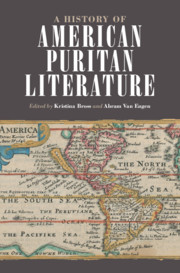Book contents
- A History of American Puritan Literature
- A History of American Puritan Literature
- Copyright page
- Dedication
- Contents
- Figures
- Contributors
- Acknowledgments
- Introduction
- Prologue
- Part I Places
- Part II Approaches
- Chapter 7 Theology
- Chapter 8 Aesthetics
- Chapter 9 Gender
- Chapter 10 Race
- Chapter 11 Print Culture
- Chapter 12 Ritual
- Chapter 13 Manuscript Culture
- Chapter 14 Environment
- Chapter 15 Science
- Chapter 16 Millennialism
- Chapter 17 Postsecularism
- Afterword
- Appendix
- Index
Chapter 9 - Gender
from Part II - Approaches
Published online by Cambridge University Press: 24 September 2020
- A History of American Puritan Literature
- A History of American Puritan Literature
- Copyright page
- Dedication
- Contents
- Figures
- Contributors
- Acknowledgments
- Introduction
- Prologue
- Part I Places
- Part II Approaches
- Chapter 7 Theology
- Chapter 8 Aesthetics
- Chapter 9 Gender
- Chapter 10 Race
- Chapter 11 Print Culture
- Chapter 12 Ritual
- Chapter 13 Manuscript Culture
- Chapter 14 Environment
- Chapter 15 Science
- Chapter 16 Millennialism
- Chapter 17 Postsecularism
- Afterword
- Appendix
- Index
Summary
Gender in American puritanism was shaped by both figurative language used in spiritual discourse and opportunities for religious activity afforded to women by puritan theology and congregational church organization. This chapter examines three broad areas in which gender was shaped and debated within American puritanism. The first is spiritual practices, especially as reflected in puritan conversion narratives. Here we see some of the most specifically puritan expressions of gender, which demonstrate a more mobile relationship between femininity and masculinity than stereotypes might suggest. Conversion narratives also constitute an important location for women’s public discourse particular to New England puritanism. The second is trials, the location of some of the best-known dramas of gender conflict that continue to incite and entertain modern audiences. In looking at trials, we get a better sense of how civil and religious law come together in the early New England colonies. We also get a glimpse into how class, race, and ethnicity inflect characterizations of gender. And despite the disciplinary framework, we also see another form of female agency and gender debate. Finally, Anne Bradstreet’s treatment of gendered embodiment provides an example of a woman poet’s participation in debates about gender.
Keywords
- Type
- Chapter
- Information
- A History of American Puritan Literature , pp. 189 - 210Publisher: Cambridge University PressPrint publication year: 2020

